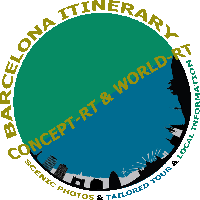Patum of Berga, fire celebration
The Patum of Berga is the famous firecracker party celebrated at Berga. It is a traditional celebration performed during the Corpus Christi and it has been declared by Catalonia government as traditional party of national interest in 1983 and after by UNESCO as masterpieces of the oral and intangible heritage of humanity in 2005. This celebration consists of diverse representations of mystical and symbolic figures which dance according to the rhythm of the music and drums and it is mainly characterized by the utilization of fire and pyrotechnic artefacts. The wednesday before the thursday of Corpus, the tabal |
|
and the giants cross the city announcing the beginning of the parties. Later, the mimic drama begins which is divided in several acts and it represents:
- the intense fights of the christians against the moors
- the archangel San Miguel, with the help of angels, fights against Lucifer and his devils
- the jeers against the arabic commander Abul-Afer (known also as Bullafer), conqueror of the area
The act of the aliga expresses the satisfaction of Berga for having finished with the feudal domain and to depend directly and exclusively of the King.
The parties take place from the thursday of Corpus until the following sunday. The following day of the proper Corpus, an infantile Patum is celebrated – it is a version adapted for children.
Following the different groups/persons who compose this celebration.
The tabal (spokesman) is the one who announces the next parties. He does it, for the first time, on sunday of the Ascension and, for the second time, on sunday of the Trinidad. The vigil of the Corpus peals again at midday but this time with the giants. It is said that his sound gives the name to the Patum. According to the tradition, the tabal has the power to clear the sky and that his sound can reach any Berga citizen who is outside of the town, no matter the distance, to announce the day of the Ascension.
The turks and cavallets (knights) are represented by 4 people dressed in turks with turbans and shining scimitars and other 4 dressed in christian with some little wood horses around their waist. They go in the middle of the place where they form 2 concentric circles to start the battle following the sound of the music expressly composed for this act. The moors chase constantly the knights who flee and always escape from their persecutors. The act reaches its climax when christians stab the moors.
The maces are the devils that carry a mace finished off with a whip (a kind of long firecracker) who dance in groups of two with San Miguel and the Angel. When the firecracker explodes, the demon falls dead on the soil. The dance finishes when all the devils are defeated and laid down on the soil.
The guites are represented by a monstrous dragon with a long neck. The goal of the guites is to persecute the people meanwhile from his mouth goes out non-stop the fire of the firecrackers. In the past, there was only one but at the end of the 19th century, another one was added named Pequeña (smaller). The aliga (eagle) is considered as the most important of the Patum.
The aliga is undoubtedly the lordliest figure, a symbol of the power which is represented by the ducal wreath and the shield of Berga that he carries. His dance is the most delicate one, with a rapid game of feet, pause and solemnity increasing with the rhythm of the music, to end up by turning on him with great speed.
The nans vells (old dwarfs). The nans vells dance and, in the same time, play castanets following the sound of waltz music. This part was incorporated into the Patum in 1855.
The Gegants (giant) There are two couples of giants, the old and the new one (this one has been added in 1891). They delight the public, especially to the infantile one, with his majestic dance.
The nans nous (new dwarfs). Dating from 1888, they are represented by two couples, the major and the young one. His music is cheerful and with a playful air.
The plens (plenary). The fire is the most representative element in the celebration of the Patum and the plens represent the infernal orgy. They are represented by 100 devils with a mask of green color and dressed with fresh grass to protect them from the fire. This party only acts during the representation of the night.
The tirabol is not a group/person but a dance in which all the groups/persons (tabal, guites and giants) have to participate. This dance is the final act of the Patum in which citizens with the giants and guites, connected by the arm, jump and dance non stop in the opposite sense of the clock during the final apotheosis of the party. When the musicians stop to play, people scream them to keep going on so that they can keep dancing, this part can be repeated in occasions up to 20 times. Since some years, at the end of the tirabol, guites return to dance in order to finish off ultimately the Guita Grossa.
So if you are in Catalonia during the month of june, don’t miss this firecracker and firework tradition celebrated at the Berga town. It is something you have to live before to leave Spain and if you want to know the exact date, check out the calendar of the official website of Berga.


